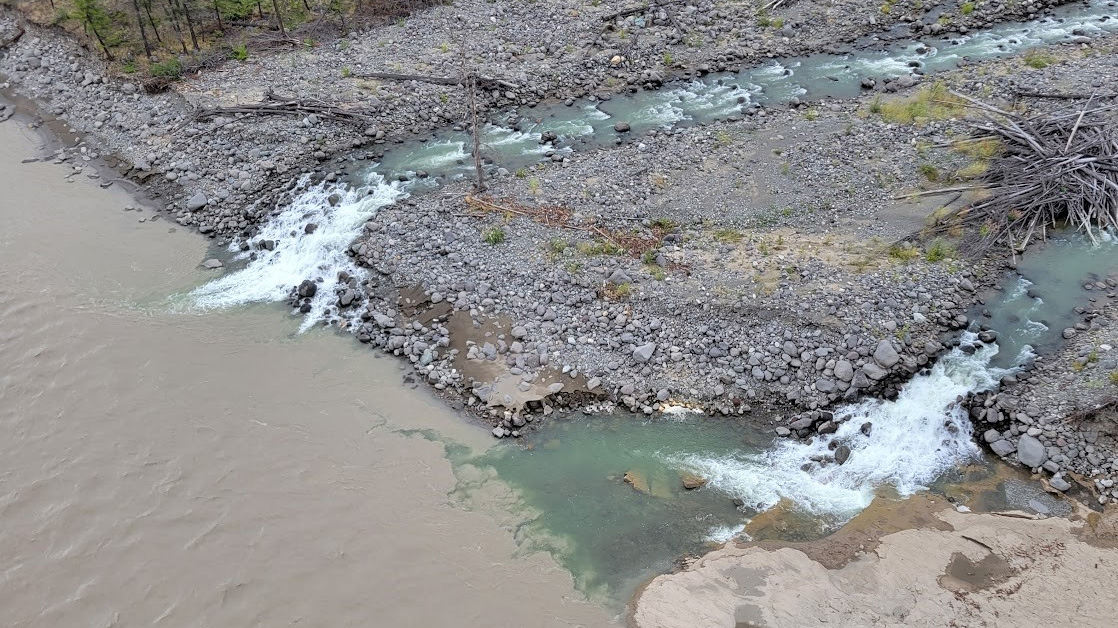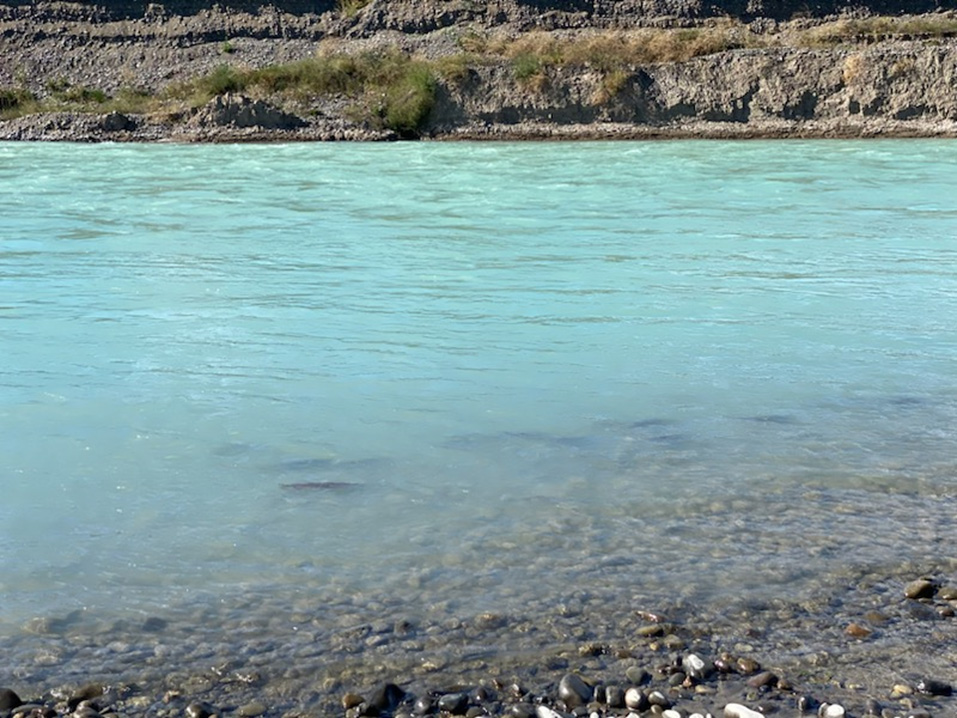Chilcotin River landslide - Pacific salmon passage update

On July 31, 2024, a landslide was discovered on the lower reaches of the Chilcotin River, about 50 km southwest of Williams Lake, BC. On August 5, water began flowing over the blockage and into the dry channel downstream. The landslide and subsequent water-flow resulted in multiple emergency evacuation orders led by the Province of British Columbia, which have since been lifted.
On September 16 and 18, two additional landslides occurred downstream of the July landslide site. Although the two new landslides were considerably smaller than the July 31 event, they resulted in temporary damming (blockage) of the Chilcotin River for several hours. Each landslide was overtopped and eroded naturally by the Chilcotin River, resulting in significantly elevated suspended sediment levels downstream from the sites for a period of several days. While adult Pacific salmon upstream migration was temporarily disrupted by the September landslide events, migration resumed shortly afterwards.
Due to ongoing geological instability of the area, the Province of British Columbia implemented an order on September 18, 2024, which prohibits public access to Crown Lands in the lower Chilcotin River (300 meters on either side of the channel). This order is scheduled to remain in place until at least January 31, 2025.
Alongside First Nations and the Province of British Columbia, we are continuing to closely monitor the situation for further slides and impacts due to winter weather conditions.
Additional information about measures to protect public safety can be found on the Province of British Columbia website.
Salmon migration
Several Pacific salmon populations return to spawn within the Chilcotin River watershed each year, including sockeye, Chinook and coho. Anadromous steelhead trout also spawn in the Chilcotin River watershed. Chinook and sockeye salmon migration occurs between July and early October, while coho salmon migrate to spawning areas in October / November and steelhead trout in the late fall/early winter period. Due to migration timing, adult coho salmon migrating into the Chilcotin River were not directly affected by the landslide events while a portion of adult Chinook salmon and the majority of adult sockeye salmon returning to the watershed in 2024 were likely affected by the slide.
Two underwater sonar stations were used to estimate the number and timing of adult Chinook and sockeye salmon migrating upstream in the Chilcotin River. The Hanceville sonar site, positioned immediately upstream of the landslide location, was used to confirm successful adult Chinook and sockeye salmon migration through the lower Chilcotin River while the Chilko Lake sonar station was used to determine the number of sockeye salmon successfully arriving at spawning location.
Sonar observations from the 2024 season (Between August 8 and October 11): 6,415 Chinook and 64,989 sockeye salmon migrated past the Hanceville Sonar Station. 48,683 sockeye salmon migrated past the Chilko Sonar Station.
As the majority of Chinook salmon returning to the Chilcotin River watershed spawn in tributary systems, as opposed to Chilko Lake, the number adult fish arriving at spawning sites is determined through aerial surveys. The lower and upper Chilcotin River, Chilko River, Punkutlaenkut Creek and Elkin Creek were surveyed.

Long text version
Chilcotin River daily salmon migration and turbidity
| Date | Chinook | Sockeye | Average daily TU |
|---|---|---|---|
| 8/24/2024 | 4 | 9 | 943.269 |
| 8/25/2024 | 3 | 15 | 759.896 |
| 8/26/2024 | 5 | 11 | 725.313 |
| 8/27/2024 | 5 | 15 | 2362.098 |
| 8/28/2024 | 6 | 60 | 1381.057 |
| 8/29/2024 | 11 | 106 | 752.515 |
| 8/30/2024 | 9 | 60 | 578.185 |
| 8/31/2024 | 54 | 120 | 480.51 |
| 9/1/2024 | 98 | 85 | 445.456 |
| 9/2/2024 | 130 | 114 | 837.753 |
| 9/3/2024 | 164 | 210 | 593.211 |
| 9/4/2024 | 194 | 130 | 435.965 |
| 9/5/2024 | 320 | 115 | 735.413 |
| 9/6/2024 | 241 | 134 | 587.251 |
| 9/7/2024 | 841 | 940 | 505.366 |
| 9/8/2024 | 1069 | 5223 | 562.195 |
| 9/9/2024 | 710 | 8426 | 494.123 |
| 9/10/2024 | 530 | 6316 | 441.483 |
| 9/11/2024 | 306 | 3947 | 402.2 |
| 9/12/2024 | 456 | 3309 | 392.013 |
| 9/13/2024 | 241 | 4644 | 740.122 |
| 9/14/2024 | 80 | 3567 | 461.42 |
| 9/15/2024 | 119 | 4410 | 838 |
| 9/16/2024 | 85 | 3358 | 3453 |
| 9/17/2024 | 31 | 1035 | 4221.712 |
| 9/18/2024 | 4 | 129 | 2156.494 |
| 9/19/2024 | 15 | 293 | 2883.784 |
| 9/20/2024 | 53 | 193 | 1340.601 |
| 9/21/2024 | 145 | 371 | 841.548 |
| 9/22/2024 | 92 | 891 | 561.809 |
| 9/23/2024 | 11 | 1354 | 465.178 |
| 9/24/2024 | 599 | 496 | 463.132 |
| 9/25/2024 | 67 | 600 | - |
Ongoing enhancement work

Chilko lake
Due to the natural passage of adult Chinook and sockeye salmon to spawning areas this season, no emergency hatchery enhancement operations are being undertaken within the Chilcotin River watershed in response to the landslide event.
In close collaboration with First Nations and community partners, we have been investing in and supporting the recovery Fraser River Pacific salmon stocks of concern. These efforts were increased following the 2019 landslide on the Fraser River mainstem at Big Bar which disrupted adult Chinook and sockeye salmon migrations and severely affected multiple at-risk stocks. Emergency conservation enhancement measures supporting Chinook and sockeye populations affected by the Big Bar slide were implemented.
Specific measures have included increased enhancement at our Inch Creek, Shuswap and Chehalis hatcheries to support Early Stuart, Taseko and Bowron sockeye populations and a number of Chinook salmon stocks. Three Indigenous-operated hatcheries and one community-operated hatchery have also undertaken stock restoration and rebuilding efforts.
Related links
- Tŝilhqot’in National Government communications
- Province of British Columbia's Chilcotin River landslide information portal
- Extreme environmental impacts on Pacific salmon
- Pacific Salmon Strategy Initiative
- Date modified: